fuel CHEVROLET EXPRESS CARGO VAN 2007 1.G Owners Manual
[x] Cancel search | Manufacturer: CHEVROLET, Model Year: 2007, Model line: EXPRESS CARGO VAN, Model: CHEVROLET EXPRESS CARGO VAN 2007 1.GPages: 458, PDF Size: 2.62 MB
Page 1 of 458
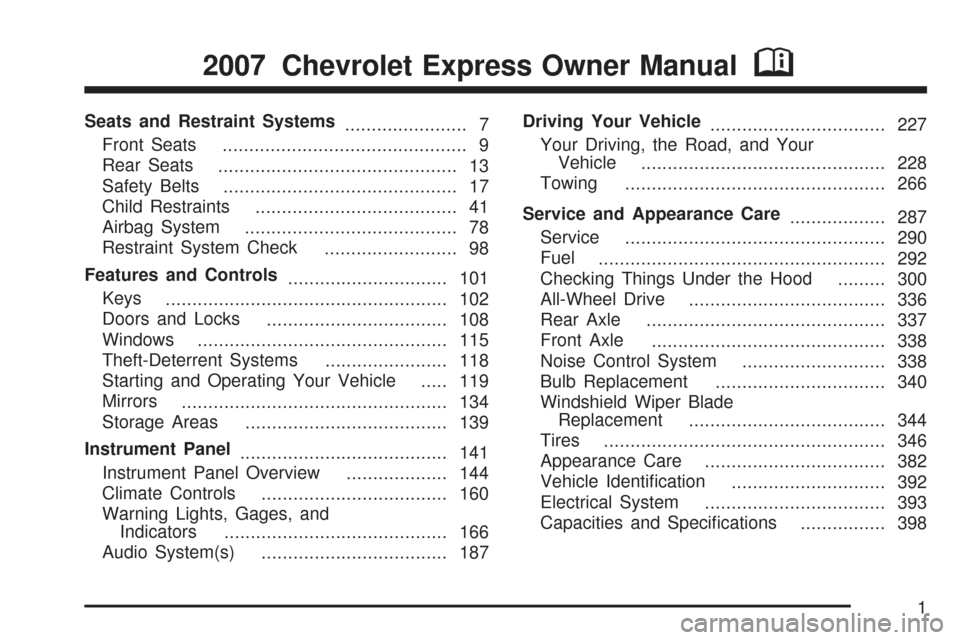
Seats and Restraint Systems
....................... 7
Front Seats
.............................................. 9
Rear Seats
............................................. 13
Safety Belts
............................................ 17
Child Restraints
...................................... 41
Airbag System
........................................ 78
Restraint System Check
......................... 98
Features and Controls
.............................. 101
Keys
..................................................... 102
Doors and Locks
.................................. 108
Windows
............................................... 115
Theft-Deterrent Systems
....................... 118
Starting and Operating Your Vehicle
..... 119
Mirrors
.................................................. 134
Storage Areas
...................................... 139
Instrument Panel
....................................... 141
Instrument Panel Overview
................... 144
Climate Controls
................................... 160
Warning Lights, Gages, and
Indicators
.......................................... 166
Audio System(s)
................................... 187Driving Your Vehicle
................................. 227
Your Driving, the Road, and Your
Vehicle
.............................................. 228
Towing
................................................. 266
Service and Appearance Care
.................. 287
Service
................................................. 290
Fuel
...................................................... 292
Checking Things Under the Hood
......... 300
All-Wheel Drive
..................................... 336
Rear Axle
............................................. 337
Front Axle
............................................ 338
Noise Control System
........................... 338
Bulb Replacement
................................ 340
Windshield Wiper Blade
Replacement
..................................... 344
Tires
..................................................... 346
Appearance Care
.................................. 382
Vehicle Identification
............................. 392
Electrical System
.................................. 393
Capacities and Specifications
................ 398
2007 Chevrolet Express Owner ManualM
1
Page 101 of 458
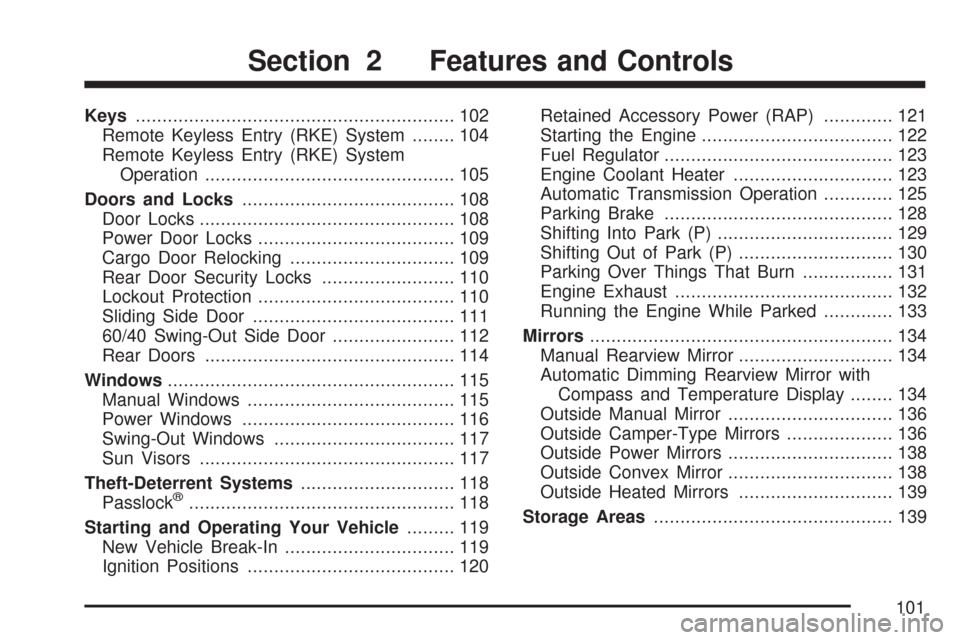
Keys............................................................ 102
Remote Keyless Entry (RKE) System........ 104
Remote Keyless Entry (RKE) System
Operation............................................... 105
Doors and Locks........................................ 108
Door Locks................................................ 108
Power Door Locks..................................... 109
Cargo Door Relocking............................... 109
Rear Door Security Locks......................... 110
Lockout Protection..................................... 110
Sliding Side Door...................................... 111
60/40 Swing-Out Side Door....................... 112
Rear Doors............................................... 114
Windows...................................................... 115
Manual Windows....................................... 115
Power Windows........................................ 116
Swing-Out Windows.................................. 117
Sun Visors................................................ 117
Theft-Deterrent Systems............................. 118
Passlock
®.................................................. 118
Starting and Operating Your Vehicle......... 119
New Vehicle Break-In................................ 119
Ignition Positions....................................... 120Retained Accessory Power (RAP)............. 121
Starting the Engine.................................... 122
Fuel Regulator........................................... 123
Engine Coolant Heater.............................. 123
Automatic Transmission Operation............. 125
Parking Brake........................................... 128
Shifting Into Park (P)................................. 129
Shifting Out of Park (P)............................. 130
Parking Over Things That Burn................. 131
Engine Exhaust......................................... 132
Running the Engine While Parked............. 133
Mirrors......................................................... 134
Manual Rearview Mirror............................. 134
Automatic Dimming Rearview Mirror with
Compass and Temperature Display........ 134
Outside Manual Mirror............................... 136
Outside Camper-Type Mirrors.................... 136
Outside Power Mirrors............................... 138
Outside Convex Mirror............................... 138
Outside Heated Mirrors............................. 139
Storage Areas............................................. 139
Section 2 Features and Controls
101
Page 118 of 458
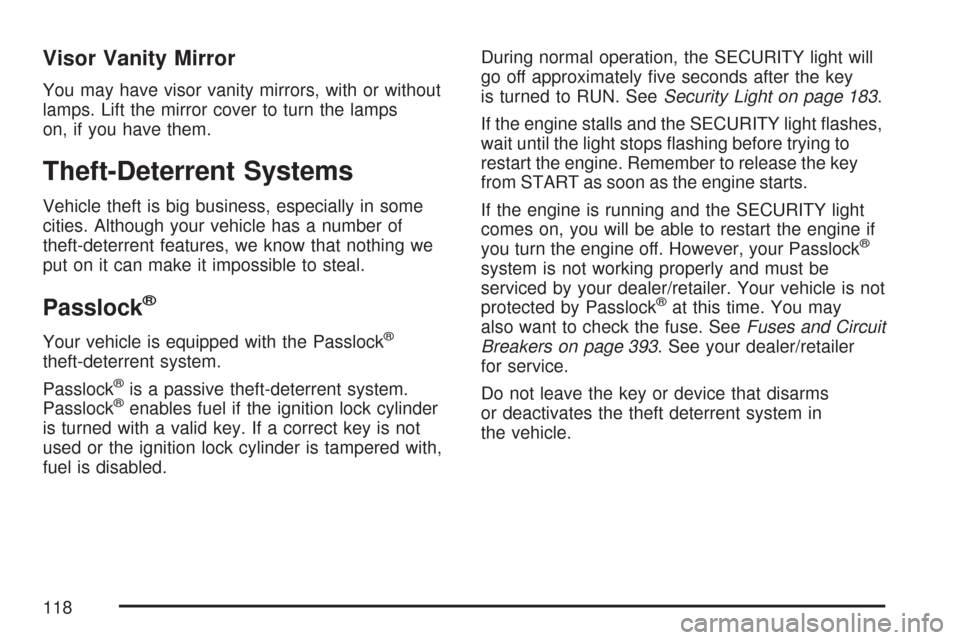
Visor Vanity Mirror
You may have visor vanity mirrors, with or without
lamps. Lift the mirror cover to turn the lamps
on, if you have them.
Theft-Deterrent Systems
Vehicle theft is big business, especially in some
cities. Although your vehicle has a number of
theft-deterrent features, we know that nothing we
put on it can make it impossible to steal.
Passlock®
Your vehicle is equipped with the Passlock®
theft-deterrent system.
Passlock
®is a passive theft-deterrent system.
Passlock®enables fuel if the ignition lock cylinder
is turned with a valid key. If a correct key is not
used or the ignition lock cylinder is tampered with,
fuel is disabled.During normal operation, the SECURITY light will
go off approximately five seconds after the key
is turned to RUN. SeeSecurity Light on page 183.
If the engine stalls and the SECURITY light flashes,
wait until the light stops flashing before trying to
restart the engine. Remember to release the key
from START as soon as the engine starts.
If the engine is running and the SECURITY light
comes on, you will be able to restart the engine if
you turn the engine off. However, your Passlock
®
system is not working properly and must be
serviced by your dealer/retailer. Your vehicle is not
protected by Passlock
®at this time. You may
also want to check the fuse. SeeFuses and Circuit
Breakers on page 393. See your dealer/retailer
for service.
Do not leave the key or device that disarms
or deactivates the theft deterrent system in
the vehicle.
118
Page 123 of 458
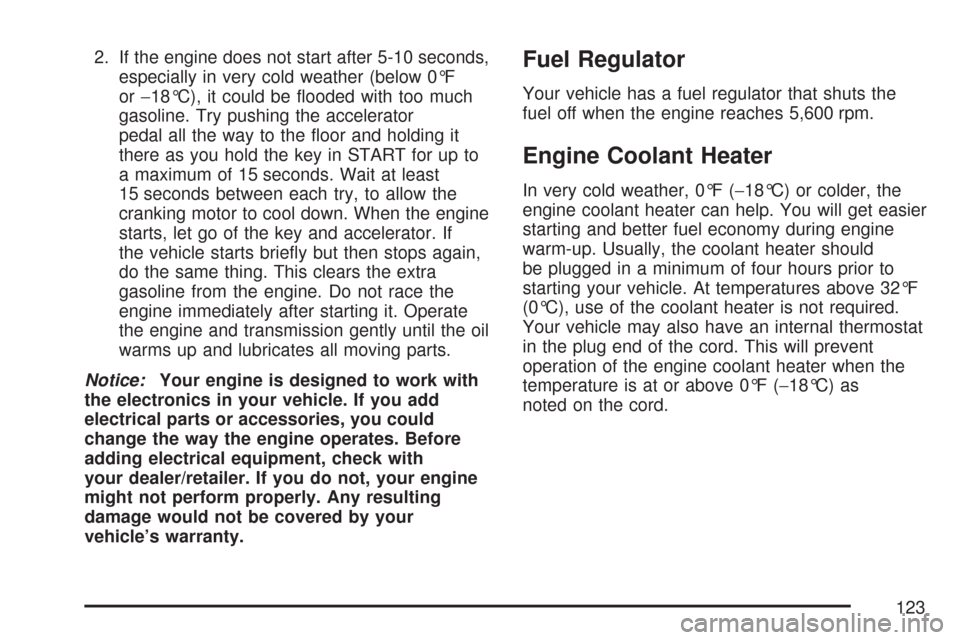
2. If the engine does not start after 5-10 seconds,
especially in very cold weather (below 0°F
or−18°C), it could be flooded with too much
gasoline. Try pushing the accelerator
pedal all the way to the floor and holding it
there as you hold the key in START for up to
a maximum of 15 seconds. Wait at least
15 seconds between each try, to allow the
cranking motor to cool down. When the engine
starts, let go of the key and accelerator. If
the vehicle starts briefly but then stops again,
do the same thing. This clears the extra
gasoline from the engine. Do not race the
engine immediately after starting it. Operate
the engine and transmission gently until the oil
warms up and lubricates all moving parts.
Notice:Your engine is designed to work with
the electronics in your vehicle. If you add
electrical parts or accessories, you could
change the way the engine operates. Before
adding electrical equipment, check with
your dealer/retailer. If you do not, your engine
might not perform properly. Any resulting
damage would not be covered by your
vehicle’s warranty.Fuel Regulator
Your vehicle has a fuel regulator that shuts the
fuel off when the engine reaches 5,600 rpm.
Engine Coolant Heater
In very cold weather, 0°F (−18°C) or colder, the
engine coolant heater can help. You will get easier
starting and better fuel economy during engine
warm-up. Usually, the coolant heater should
be plugged in a minimum of four hours prior to
starting your vehicle. At temperatures above 32°F
(0°C), use of the coolant heater is not required.
Your vehicle may also have an internal thermostat
in the plug end of the cord. This will prevent
operation of the engine coolant heater when the
temperature is at or above 0°F (−18°C) as
noted on the cord.
123
Page 127 of 458
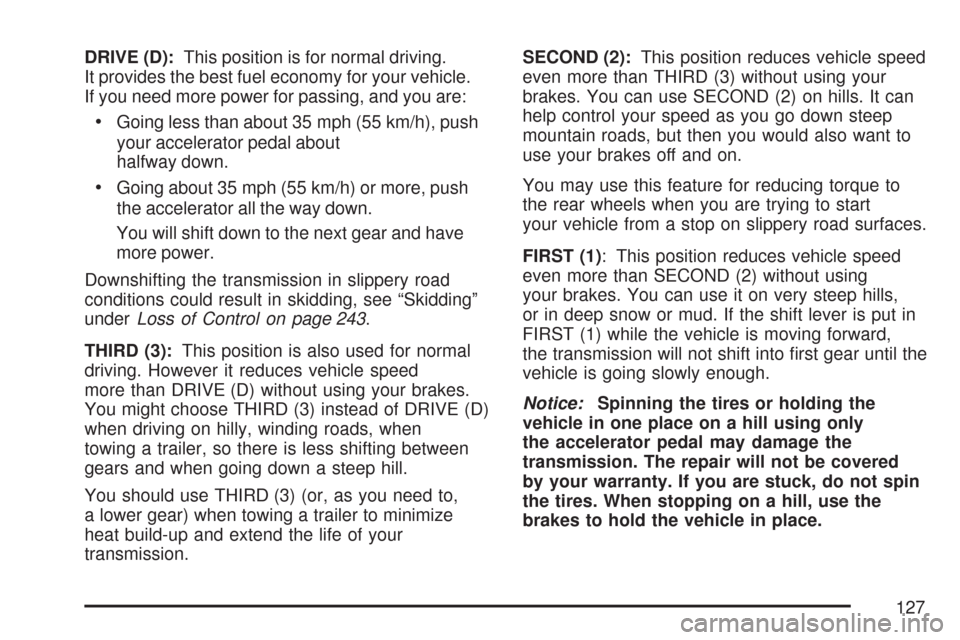
DRIVE (D):This position is for normal driving.
It provides the best fuel economy for your vehicle.
If you need more power for passing, and you are:
•Going less than about 35 mph (55 km/h), push
your accelerator pedal about
halfway down.
•Going about 35 mph (55 km/h) or more, push
the accelerator all the way down.
You will shift down to the next gear and have
more power.
Downshifting the transmission in slippery road
conditions could result in skidding, see “Skidding”
underLoss of Control on page 243.
THIRD (3):This position is also used for normal
driving. However it reduces vehicle speed
more than DRIVE (D) without using your brakes.
You might choose THIRD (3) instead of DRIVE (D)
when driving on hilly, winding roads, when
towing a trailer, so there is less shifting between
gears and when going down a steep hill.
You should use THIRD (3) (or, as you need to,
a lower gear) when towing a trailer to minimize
heat build-up and extend the life of your
transmission.SECOND (2):This position reduces vehicle speed
even more than THIRD (3) without using your
brakes. You can use SECOND (2) on hills. It can
help control your speed as you go down steep
mountain roads, but then you would also want to
use your brakes off and on.
You may use this feature for reducing torque to
the rear wheels when you are trying to start
your vehicle from a stop on slippery road surfaces.
FIRST (1): This position reduces vehicle speed
even more than SECOND (2) without using
your brakes. You can use it on very steep hills,
or in deep snow or mud. If the shift lever is put in
FIRST (1) while the vehicle is moving forward,
the transmission will not shift into first gear until the
vehicle is going slowly enough.
Notice:Spinning the tires or holding the
vehicle in one place on a hill using only
the accelerator pedal may damage the
transmission. The repair will not be covered
by your warranty. If you are stuck, do not spin
the tires. When stopping on a hill, use the
brakes to hold the vehicle in place.
127
Page 132 of 458
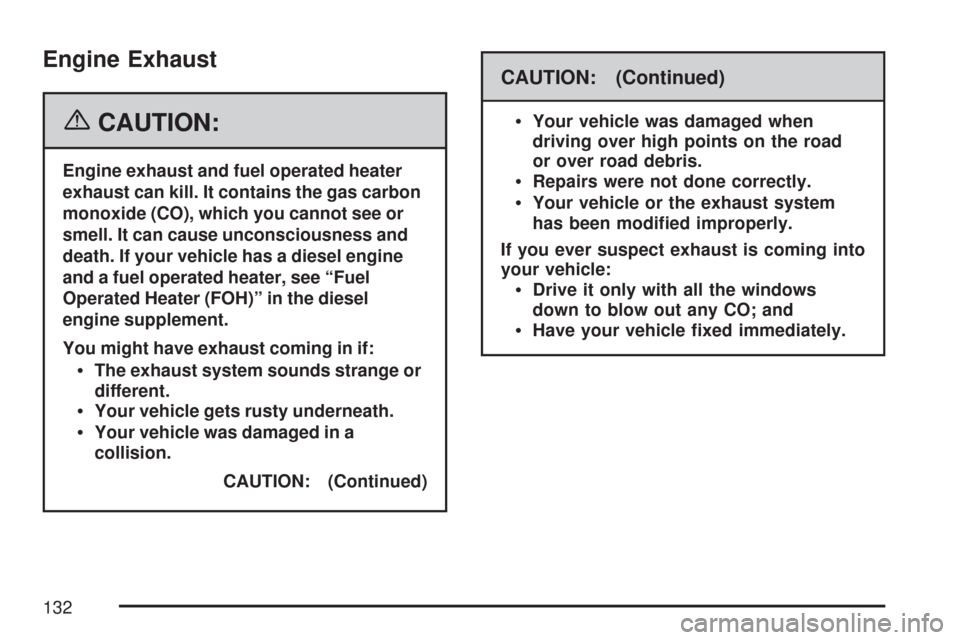
Engine Exhaust
{CAUTION:
Engine exhaust and fuel operated heater
exhaust can kill. It contains the gas carbon
monoxide (CO), which you cannot see or
smell. It can cause unconsciousness and
death. If your vehicle has a diesel engine
and a fuel operated heater, see “Fuel
Operated Heater (FOH)” in the diesel
engine supplement.
You might have exhaust coming in if:
The exhaust system sounds strange or
different.
Your vehicle gets rusty underneath.
Your vehicle was damaged in a
collision.
CAUTION: (Continued)
CAUTION: (Continued)
Your vehicle was damaged when
driving over high points on the road
or over road debris.
Repairs were not done correctly.
Your vehicle or the exhaust system
has been modi�ed improperly.
If you ever suspect exhaust is coming into
your vehicle:
Drive it only with all the windows
down to blow out any CO; and
Have your vehicle �xed immediately.
132
Page 142 of 458
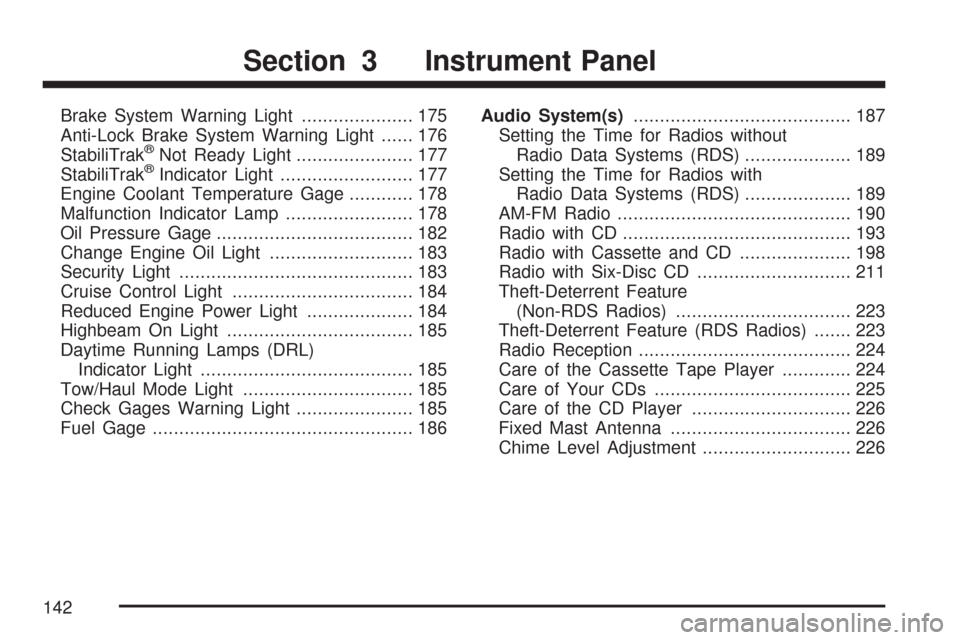
Brake System Warning Light..................... 175
Anti-Lock Brake System Warning Light...... 176
StabiliTrak
®Not Ready Light...................... 177
StabiliTrak®Indicator Light......................... 177
Engine Coolant Temperature Gage............ 178
Malfunction Indicator Lamp........................ 178
Oil Pressure Gage..................................... 182
Change Engine Oil Light........................... 183
Security Light............................................ 183
Cruise Control Light.................................. 184
Reduced Engine Power Light.................... 184
Highbeam On Light................................... 185
Daytime Running Lamps (DRL)
Indicator Light........................................ 185
Tow/Haul Mode Light................................ 185
Check Gages Warning Light...................... 185
Fuel Gage................................................. 186Audio System(s)......................................... 187
Setting the Time for Radios without
Radio Data Systems (RDS).................... 189
Setting the Time for Radios with
Radio Data Systems (RDS).................... 189
AM-FM Radio............................................ 190
Radio with CD........................................... 193
Radio with Cassette and CD..................... 198
Radio with Six-Disc CD............................. 211
Theft-Deterrent Feature
(Non-RDS Radios)................................. 223
Theft-Deterrent Feature (RDS Radios)....... 223
Radio Reception........................................ 224
Care of the Cassette Tape Player............. 224
Care of Your CDs..................................... 225
Care of the CD Player.............................. 226
Fixed Mast Antenna.................................. 226
Chime Level Adjustment............................ 226
Section 3 Instrument Panel
142
Page 167 of 458
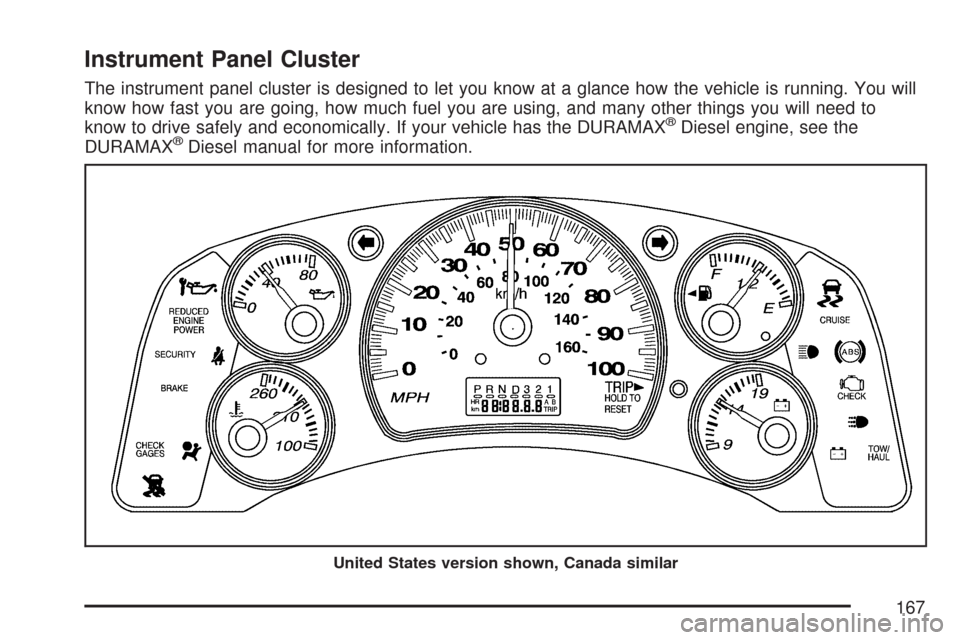
Instrument Panel Cluster
The instrument panel cluster is designed to let you know at a glance how the vehicle is running. You will
know how fast you are going, how much fuel you are using, and many other things you will need to
know to drive safely and economically. If your vehicle has the DURAMAX
®Diesel engine, see the
DURAMAX®Diesel manual for more information.
United States version shown, Canada similar
167
Page 178 of 458
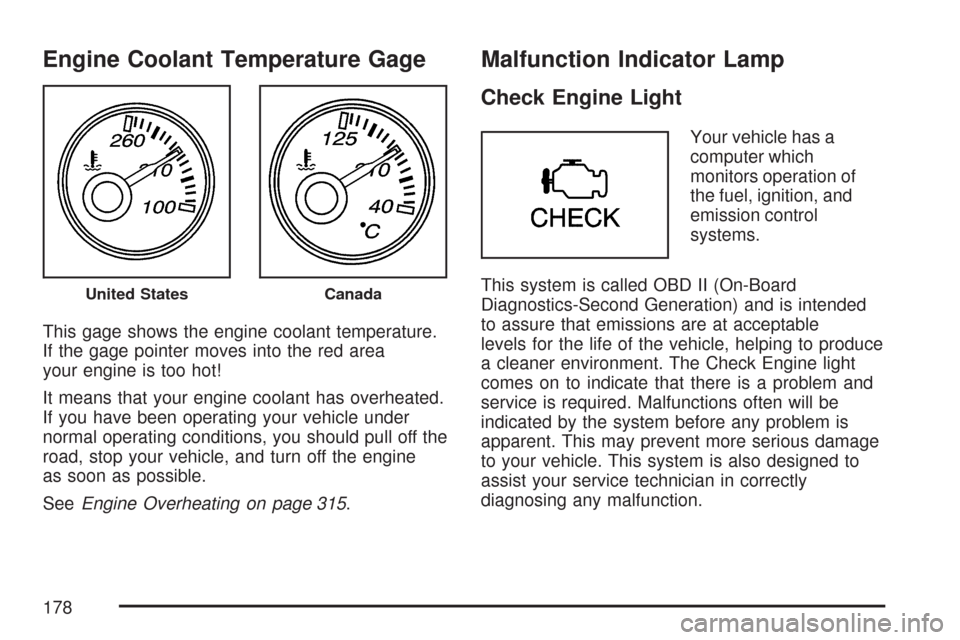
Engine Coolant Temperature Gage
This gage shows the engine coolant temperature.
If the gage pointer moves into the red area
your engine is too hot!
It means that your engine coolant has overheated.
If you have been operating your vehicle under
normal operating conditions, you should pull off the
road, stop your vehicle, and turn off the engine
as soon as possible.
SeeEngine Overheating on page 315.
Malfunction Indicator Lamp
Check Engine Light
Your vehicle has a
computer which
monitors operation of
the fuel, ignition, and
emission control
systems.
This system is called OBD II (On-Board
Diagnostics-Second Generation) and is intended
to assure that emissions are at acceptable
levels for the life of the vehicle, helping to produce
a cleaner environment. The Check Engine light
comes on to indicate that there is a problem and
service is required. Malfunctions often will be
indicated by the system before any problem is
apparent. This may prevent more serious damage
to your vehicle. This system is also designed to
assist your service technician in correctly
diagnosing any malfunction.
United StatesCanada
178
Page 179 of 458
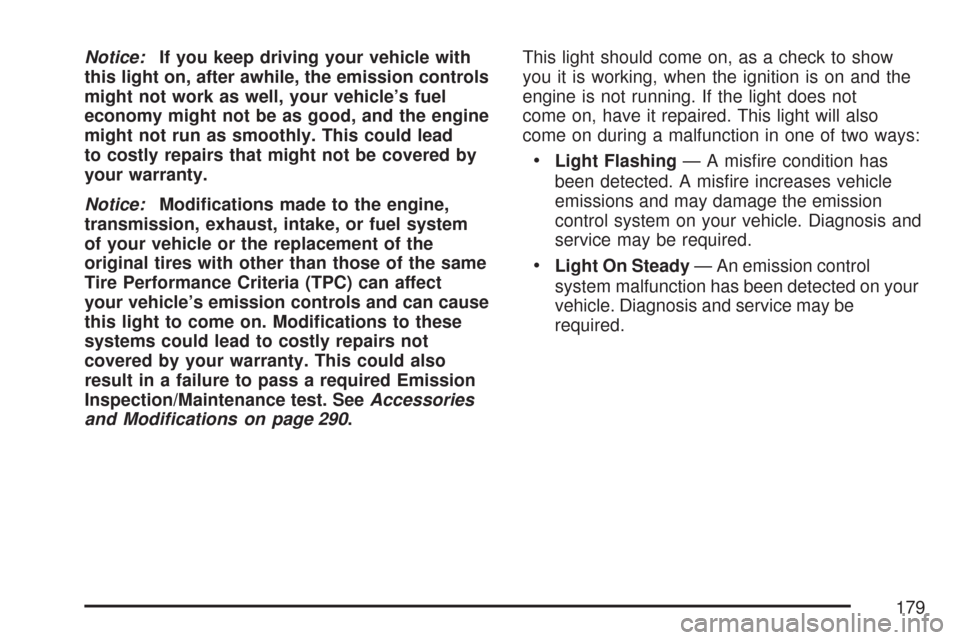
Notice:If you keep driving your vehicle with
this light on, after awhile, the emission controls
might not work as well, your vehicle’s fuel
economy might not be as good, and the engine
might not run as smoothly. This could lead
to costly repairs that might not be covered by
your warranty.
Notice:Modi�cations made to the engine,
transmission, exhaust, intake, or fuel system
of your vehicle or the replacement of the
original tires with other than those of the same
Tire Performance Criteria (TPC) can affect
your vehicle’s emission controls and can cause
this light to come on. Modi�cations to these
systems could lead to costly repairs not
covered by your warranty. This could also
result in a failure to pass a required Emission
Inspection/Maintenance test. SeeAccessories
and Modifications on page 290.This light should come on, as a check to show
you it is working, when the ignition is on and the
engine is not running. If the light does not
come on, have it repaired. This light will also
come on during a malfunction in one of two ways:
•Light Flashing— A misfire condition has
been detected. A misfire increases vehicle
emissions and may damage the emission
control system on your vehicle. Diagnosis and
service may be required.
•Light On Steady— An emission control
system malfunction has been detected on your
vehicle. Diagnosis and service may be
required.
179